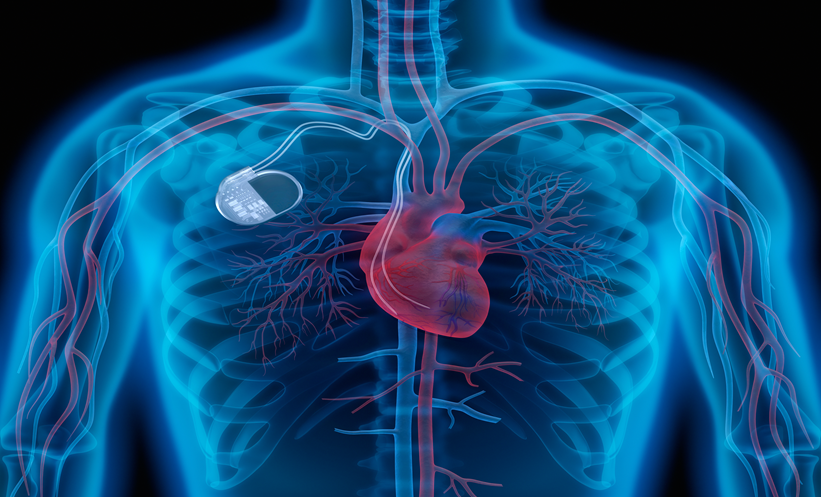Theo Wolf | Senior Editorial Assistant
![]()
ARTIFICIAL intelligence (AI) has begun to permeate and revolutionise interventional cardiology. Multimodality images, ECGs, electronic health records, and other routine medical media store underutilised patient data. AI has the capacity to learn from these data sources and apply knowledge from them to distinct medical circumstances. At this year’s EuroPCR, a panel of experts explored a number of ways in which AI can be applied to the field in order to improve existing gaps in cardiovascular medical practice.
ARTIFICIAL INTELLIGENCE AND CORONARY ARTERY DISEASE
Coronary angiography is the gold standard for diagnosis and management of coronary artery disease. “As interventionalists, we use visual assessment as the de facto method for determining the severity of coronary artery disease,” said Robert Avram, Montreal Heart Institute, Canada. However, Avram emphasised that this measurement suffers from significant intra- and interobserver variability. Consequently, Avram and colleagues considered whether it was possible to “develop an AI algorithm that will be able to fully interpret the coronary angiogram and reduce or minimise the variability.”
Data from approximately 11,000 patients at the University of California, San Francisco, California, USA, were used for development and internal validation of the algorithm. In addition, “we also took 464 patients at the Ottawa Heart Institute [Canada], and we paired the images of the angiograms with the coronary angiography report,” explained Avram. “We do angiograms of many vessels, not only the coronaries. We can do an angiogram of the renal artery or the femoral artery. So, it was very important for us to restrict this algorithm to the left and right coronary artery,” noted Avram.
The algorithm was built to perform four different tasks: projection angle detection (Algorithm 1); anatomic structure identification (Algorithm 2); anatomy and stenosis localisation (Algorithm 3); and prediction of coronary stenosis severity (Algorithm 4). Avram revealed that “Algorithm 2 was able to identify left and right coronary arteries in 97 and 93% of cases in San Francisco, and 100% of the cases in Ottawa.” Furthermore, “Algorithm 3 was able to localise 94% of the stenosis in San Francisco and 85% of the stenosis in Ottawa when compared to the angiogram report,” highlighted Avram.
Regarding stenosis severity (discriminating between severe [≥70%] and non-severe stenosis), areas under the receiver operating characteristic curves (AUROC) of 0.862 and 0.869 were calculated for the University of California, San Francisco and Ottawa datasets, respectively. “This was a first proof that we can develop an AI algorithm that can take an angiogram, localise the stenosis, and predict the severity with a pretty good performance,” summarised Avram.
The researchers also explored quantitative coronary angiograms (QCA) because visual assessment is an imperfect label, according to Avram. In total, data from 419 patients were extracted, and 1,098 lesions were isolated on the coronary angiogram with core-lab adjudicated QCA readings. The group applied the previous algorithm, called CathAI, to predict severe stenosis from non-severe stenosis on QCA-labelled datasets, and used a 50% cut-off on QCA. An AUROC of 0.73 was obtained for CathAI to detect a severe stenosis against QCA. “CathAI was replicating the visual bias, or the human bias, which is to overestimate severe stenosis, leading to over-stenting down the line,” concluded Avram. Going forward, Avram and collaborators are “re-training this algorithm with QCA labels to have a less biased predictive value.”
Even though most of the work previously done on coronary angiograms uses images of the vessels, videos can also be used, and these offer much richer datasets. The movement of the right coronary artery with each heartbeat and also the breathing of a patient makes it difficult for an AI algorithm to focus on one particular area. For this reason, the researchers built an algorithm to stabilise the vessel, meaning it adjusts for breathing and heart rate variability. Using this type of data, it is possible to determine the instantaneous wave-free ratio and fractional flow reserve. Work is also underway to “derive automated SYNTAX score to describe the plaque assessment such as calcification, the bifurcation type, and disease severity using stabilised videos of coronary vessels.”
Avram finished by presenting a roadmap for AI implementation in medicine. This comprised five distinct stages: data generation; AI algorithm training; AI algorithm internal and external validation; randomised controlled trial demonstrating a positive impact on outcomes; and, finally, deployment of AI in clinical practice.
ARTIFICIAL INTELLIGENCE AND STRUCTURAL HEART DISEASE
Timothy Poterucha, Columbia University, New York City, New York, USA, expressed his belief that “AI is going to fundamentally change our approach to structural heart disease in the next decade across the patient journey.” Poterucha began by considering initial suspicion of structural heart disease. “Over the last 15 years, we have seen TAVI [transcatheter aortic valve implantation] quickly progress, initially from inoperable to high-risk patients, pushing into intermediate and low-risk patients. At each step, we’ve seen improved outcomes along the way,” said Poterucha.
Now, studies are investigating transcatheter aortic valve implantation in asymptomatic individuals and those with moderate aortic stenosis that is complicated by heart failure. Clearly, there is a trend toward treating patients earlier and earlier when they have asymptomatic valvular heart disease. Therefore, in the next decade, wide-scale screening programmes will be necessary in order to detect asymptomatic, severe valvular heart disease. Currently, less than half of those patients with severe aortic stenosis have been clinically detected. “Most of those patients are enrolled in care, they are seeing doctors regularly, but that murmur isn’t heard […] and if we can’t detect these patients, we can’t change the natural history of the disease.” The ideal way to screen all these patients would be to perform wide-scale echocardiography; however, this is expensive and requires expertise to obtain the images and interpret them. Therefore, Poterucha and his group asked the following research question: can AI analysis of 12-lead ECG detect moderate or severe valvular heart disease? To answer this, data were collected from 77,163 patients who had an ECG done within a year prior to an echo. “We split this data up into train, validation, and test sets,” revealed Poterucha.
The group inserted the ECG raw waveform and ran these inputs through calculation layers. After the input was run through these calculation layers, an output was generated. In this case, the group investigated whether the patient’s echocardiogram came from someone with moderate or severe aortic stenosis, aortic regurgitation, or mitral regurgitation. The model, developed by Poterucha and colleagues, was shown to accurately predict aortic stenosis with an AUROC of 0.88. In addition, the model predicted aortic regurgitation and mitral regurgitation with AUROCs of 0.77 and 0.83, respectively. “It can do very similarly in a composite model that’s looking for any of these three diseases,” continued Poterucha. In summary, deep learning can be used to analyse an ECG to detect a combination of several valvular heart lesions. As highlighted by Poterucha, the aim is to deploy this in patients. Currently, a 200-patient clinical trial is being conducted at Columbia. Whenever an ECG is performed, it is put into the research servers and then run, in real-time, through deep learning models. If a patient with a high probability of valvular heart disease has not had an echo recently, they are recruited as part of the prospective clinical trial. “Our goal is to take these algorithms, develop them in retrospective datasets, and then prove that they work through prospective clinical trials,” said Poterucha.
Poterucha next considered diagnosis and emphasised that ECGs are highly standardised and amenable to rule-based interpretation. However, the average echocardiogram is composed of around 100 clips, each of which is around 3 seconds long, and there are around 30 frames per second. This yields a total of 10,000 frames per echocardiogram, which is much more complex than an ECG that has 12 leads for 10 seconds at 250 Hz. The issue of complexity is compounded by the high variability between patients. Although rule-based interpretation models cannot process complex forms of data, AI can. The current state of the art is accurate view identification and structure segmentation, as well as left ventricular quantification similar to that achieved by cardiologists. In the near future, research will focus on preliminary report drafting and phenotype detection. Phenotype detection is a particularly exciting prospect, which involves training a series of deep learning models to look for the signals indicating that a patient might have a specific diagnosis, such as cardiac amyloidosis or low-flow, low-gradient aortic stenosis. This will allow cardiologists to target particular interventions at these patients.
According to Poterucha, the first advancement in terms of treatment will be improved prognostication. A recent study employed a variety of machine learning and traditional statistic methods to identify the minimum number of factors associated with prognosis. Overall, six variables (blood urea nitrogen, creatinine, haemoglobin, BMI, mean arterial pressure, and N-terminal pro B-type natriuretic peptide) yielded an AUROC of 0.772 in predicting mortality using the XGBoost machine learning technique. Poterucha highlighted two caveats of this research, namely that these clinical factors were already known to impact prognosis and that logistic regression was almost as good as the machine learning techniques. The second advance is going to be in treatment planning. Poterucha predicts that automated analysis of CT for annulus sizing will become mainstream in the next 5 years. However, although this software will shorten analytic time and match, Poterucha does not anticipate that it will outperform
experienced readers.
CONCLUSION
Advances in AI and machine learning will positively impact the management of both coronary artery disease and structural heart disease across the patient journey, from improved patient identification to enhanced prognostication and faster treatment planning. Importantly, AI advances should be optimised to automate many of the computer tasks that currently take up much of medical practice, enabling interventionalists to spend more time in direct patient care.








